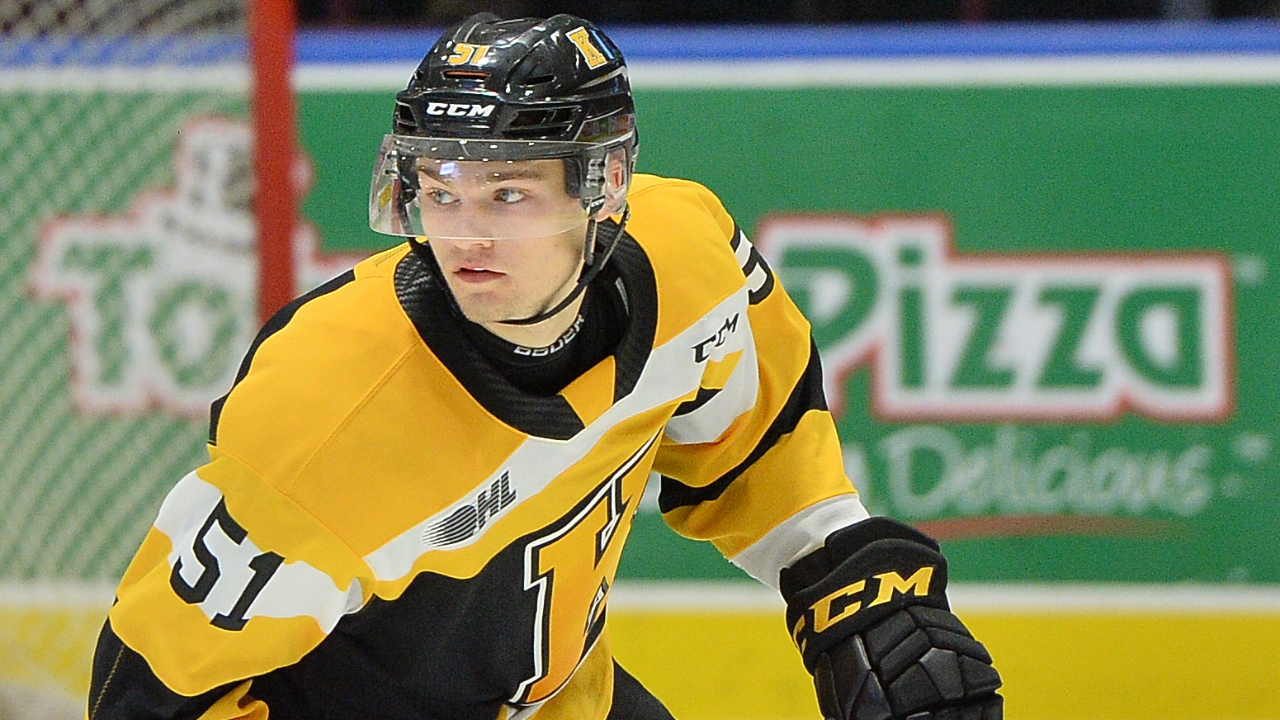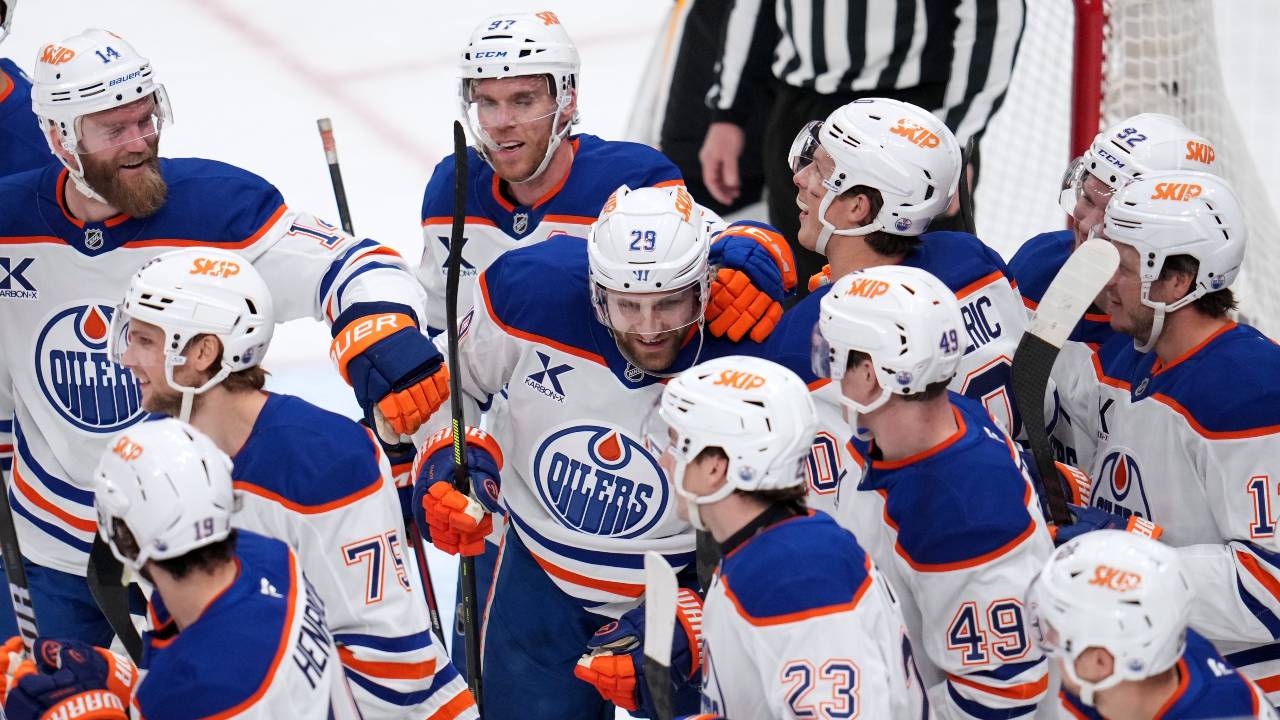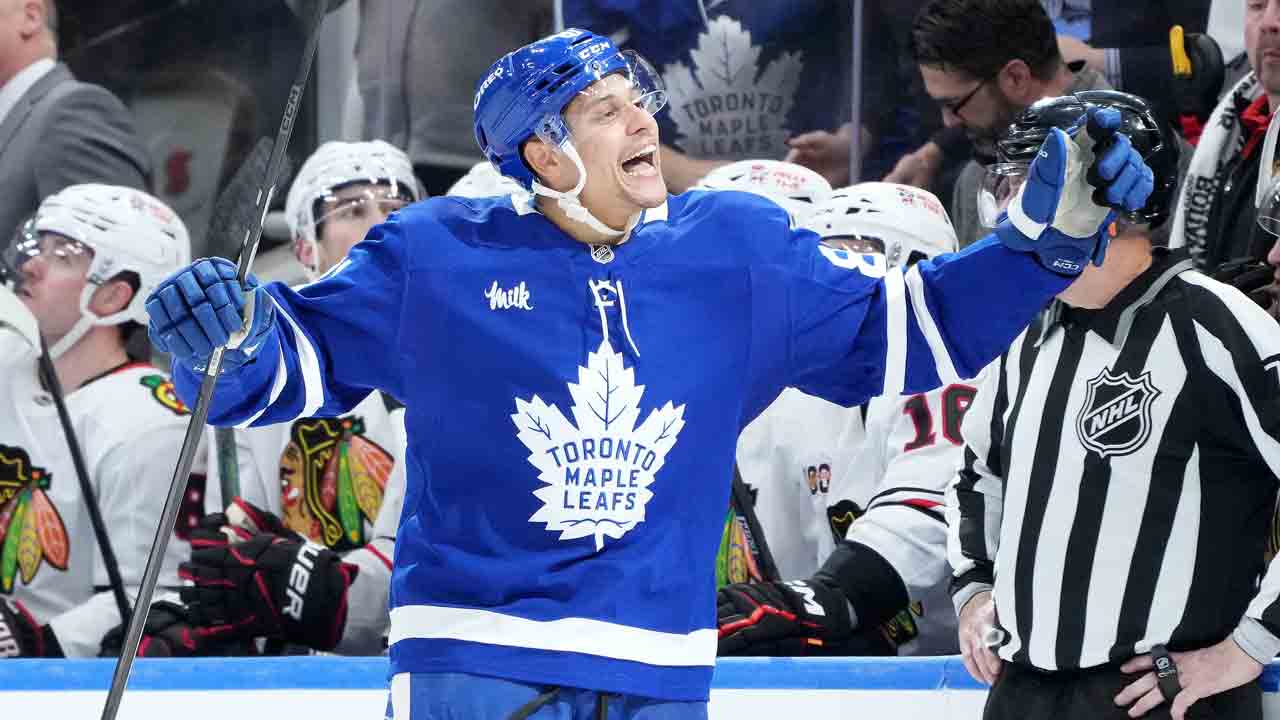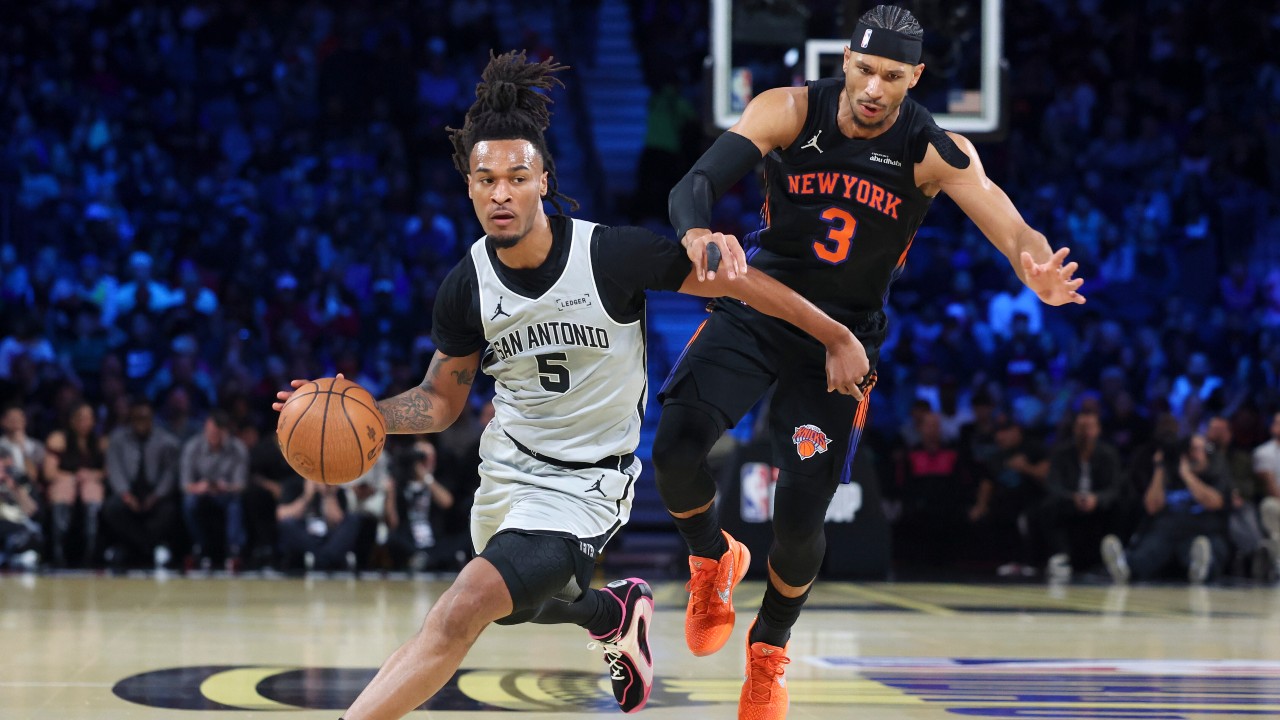
SID AND THE KID
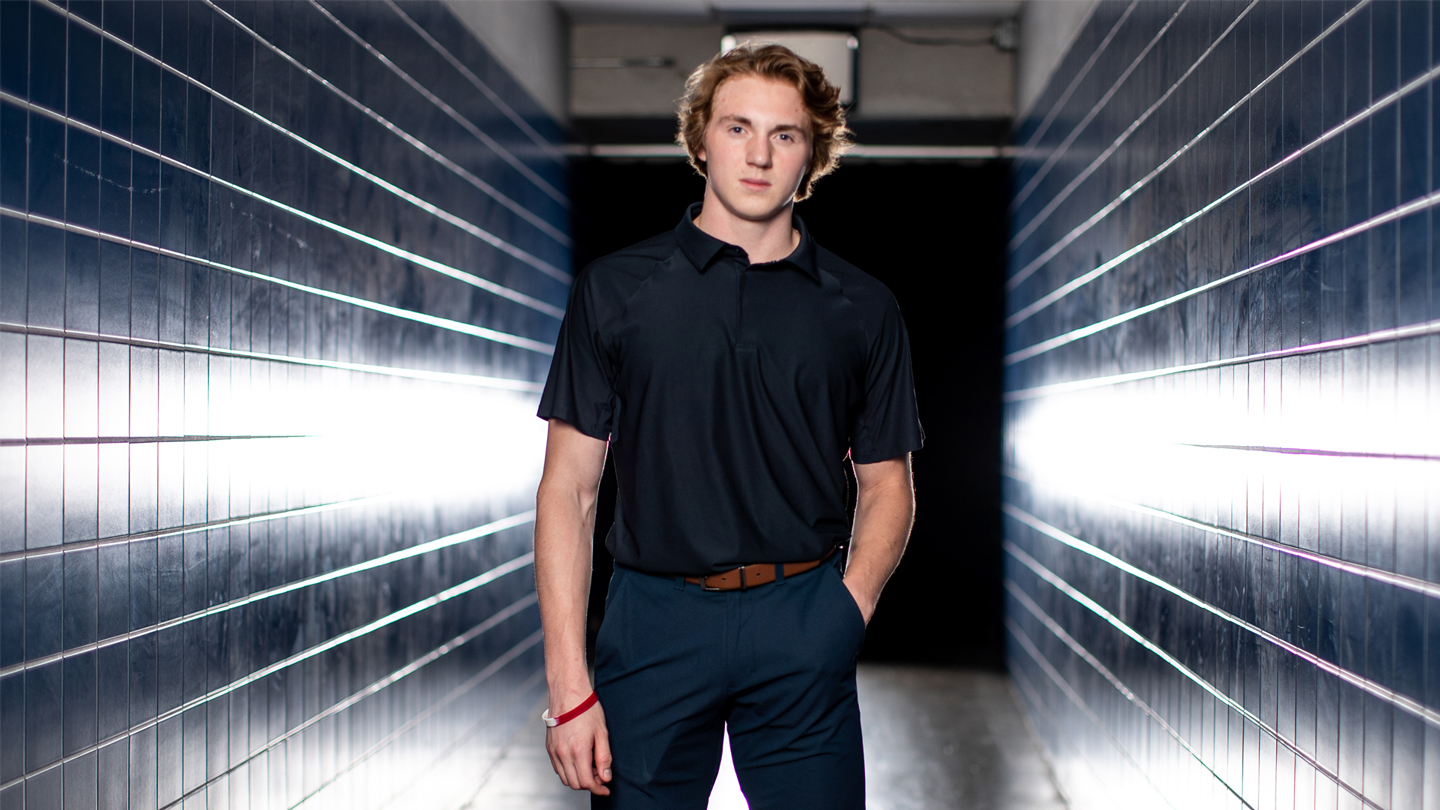
T
he thought crosses Logan Cooley’s mind every time he drives by the arena, every time he sees those five Stanley Cup banners looking out over downtown Pittsburgh’s Centre Avenue. It’s when that familiar scene blurs past his window that Cooley lets his mind wander to what the moment would be like: taking that first step onto the ice at PPG Paints Arena as a bona fide NHLer. Spotting his family up in the frenzied crowd. Maybe hearing some cheers trickle down for the hometown kid, even if he’s wearing the opposing team’s jersey. Lining up at centre ice across from Sidney Crosby, No. 87 himself.
For anyone whose story started where Cooley’s did, here in Pittsburgh in the shadow of Crosby’s greatness, there are some undeniable butterflies spurred up by the thought of playing in front of that Steel City crowd one day. But for Cooley, it’s something else entirely, because the 18-year-old’s journey isn’t quite like anyone else’s.
Cooley isn’t just a Pittsburgh kid who dreams of playing in front of the Penguins faithful, or one of the many inspired by Crosby and his club. The connection between him and the captain, between him and the team, runs much deeper. Back before his ascent through the youth hockey ranks — the hype around his name growing first locally, then nationally, then internationally — Cooley was one of a bunch of five-year-olds puttering around the ice under the watchful eye of Crosby himself. He was among a group of kids who got their start in the game because of the captain, gifted free hockey gear by No. 87’s Little Penguins program.
When that program started, the goal was just to get more kids in Pittsburgh playing hockey, to give local families an easier path to getting involved in the sport. Now, a decade and a half later, Crosby’s efforts in Pittsburgh have spawned something far greater than he or the Penguins expected: a blue-chip talent in Cooley, who took that seed from the black-and-gold and nurtured it into a dominant young career in the game, set to culminate at the 2022 NHL Draft, where his name’s expected to be among the first few called.
For Cooley, that moment up on the Draft’s stage will be a dream come true. But it might be just as meaningful for Pittsburgh, watching the young centreman become the highest-drafted player to ever come from the city, seeing how far their hockey community has come.
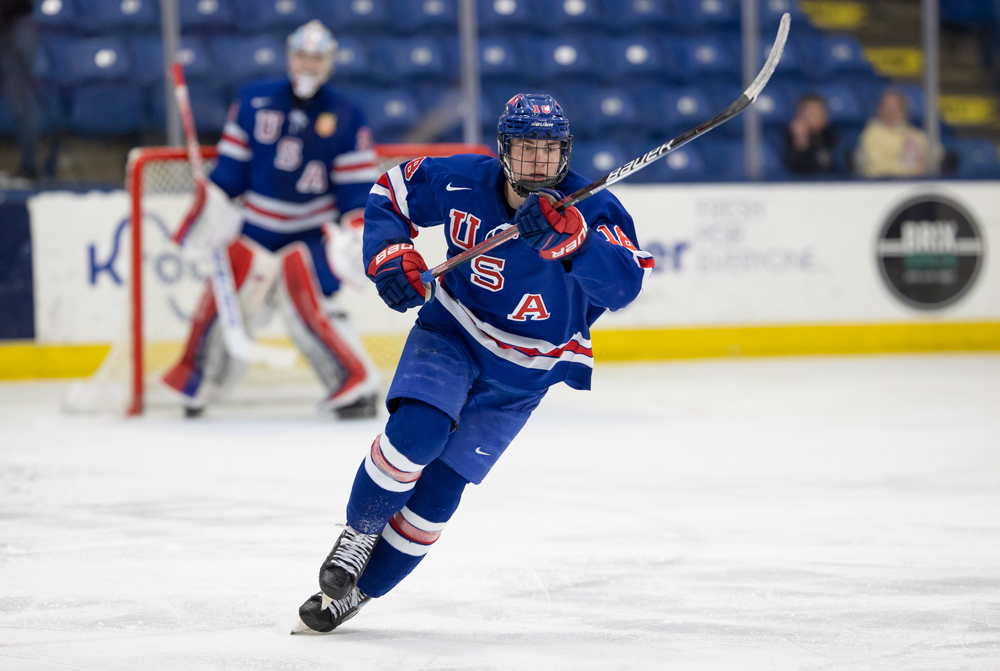
D
espite his unique connection to the Penguins, to Pittsburgh, Cooley’s days as a young hockey fan were spent rooting for one of his city’s most fierce rivals. “I actually grew up a Capitals fan, so it was a little crazy. I’m a big [Alex Ovechkin] fan,” he says. “Ever since I was young, I always liked the way Ovie competed, the way he celebrated his goals and little things like that. I’m still a Pittsburgh fan, still a Crosby fan — it’s just, the Capitals are my No. 1.
“I always would root for them when they would play against the Penguins, so I just remember a lot of heartbreak in the playoffs. … Until 2018.”
While watching Ovechkin finally hoist the Cup that year remains one of Cooley’s most cherished hockey memories, his earliest recollection of his own life on the ice began a decade prior, as Crosby was on his way to winning his first title. It was in 2008, sandwiched between Cup Final disappointment and his first ring, that Crosby met with Penguins brass to figure out a way to make the game more accessible for young families in his adopted hometown. “The vision for the Little Penguins program really came from a conversation that our former president and CEO, David Morehouse, had with Sid back in the 2007-08 season,” says Rich Hixon, who worked closely with Morehouse on the Penguins’ youth hockey initiatives before moving into his current role as senior vice president of facilities four years ago. “Really the focus of it was we were looking to grow the game and really make this an opportunity for Pittsburgh to become a hockey town.”
“Sid came to me originally,” Morehouse said in a 2021 interview with NBC. “He said he wanted to figure out how to make it easier for kids to play hockey, to kind of take down some of the economic barriers.” Morehouse himself had been thinking the same thing. “He had kids going through hockey and a son in particular that was doing fairly well,” remembers Colby Armstrong, now a broadcaster with Sportsnet, who was then at the tail end of his Penguins career. “So, I think he saw a need where the Penguins could step up a lot more in the community.”
The idea was a simple one. Between the team, Crosby, and a couple sponsors, the Penguins would provide kids between the ages of five and nine free head-to-toe equipment, properly fitted, and 10 on-ice sessions. Six hundred kids enrolled right off the bat, and even more wanted in. So the Penguins increased the number of players they outfitted each year, averaging roughly a thousand per year since. All in all, around 14,000 children have taken their first spins as Little Penguins.
And during the program’s very first season, in 2008-09, among the first crop of kids to take the ice with Crosby, was Cooley.
“I was pretty young, so I don’t remember too much. I just remember having a blast out there,” Cooley says. While his five-year-old self might not have recognized the magnitude of the opportunity to be on the ice with Crosby at the time, to get firsthand instruction from the future Hall of Famer, he certainly does now. “I know I was really young, but any time you can learn anything from him to try and put in your game, it’s pretty special. And something that not a lot of people get to do.”
Cooley wasn’t exactly starting from scratch. Though his first foray into the game came in that Little Penguins program, his family is a staple in the local hockey community. Uncles Tom and John Mooney both played college hockey, before the latter became a well-known coach in Pittsburgh. Older brothers Eric and Riley both played and found some success in the game, too, and three of Cooley’s cousins — LJ, Kaley and Ireland Mooney — are making their way in the sport as well.
Hockey was going to find Logan Cooley at some point. But he doesn’t discount the impact that first experience had on how quickly he took to the game. “I’m sure I still would have tried hockey, at least. But I think being able to go out there with Sidney Crosby made it a lot more fun,” he says. “It’s hard to say where I would be right now if it wasn’t for that. It got me to love the game even more.”
Once he was hooked on the sport, young Cooley bounced around a couple local AA teams in those early years, first the Mon Valley Thunder, then the Pittsburgh Predators. Neither program proved a good fit, the gap between his skillset and that of the kids around him already noticeable. In 2015, he found a worthy challenge by going back to where it all began — joining the triple-A program run by the Penguins, the Pittsburgh Penguins Elite. “That was really the first time I was surrounded by extremely good Pittsburgh players,” Cooley says. “Before that, I was just playing AA at the time, the kids weren’t really close. … When I first went to the Pens Elite, there were a few good players on the team that, you know, you had to compete against, that were really good. It was my first time being in a real competitive [environment]when I was playing hockey.”
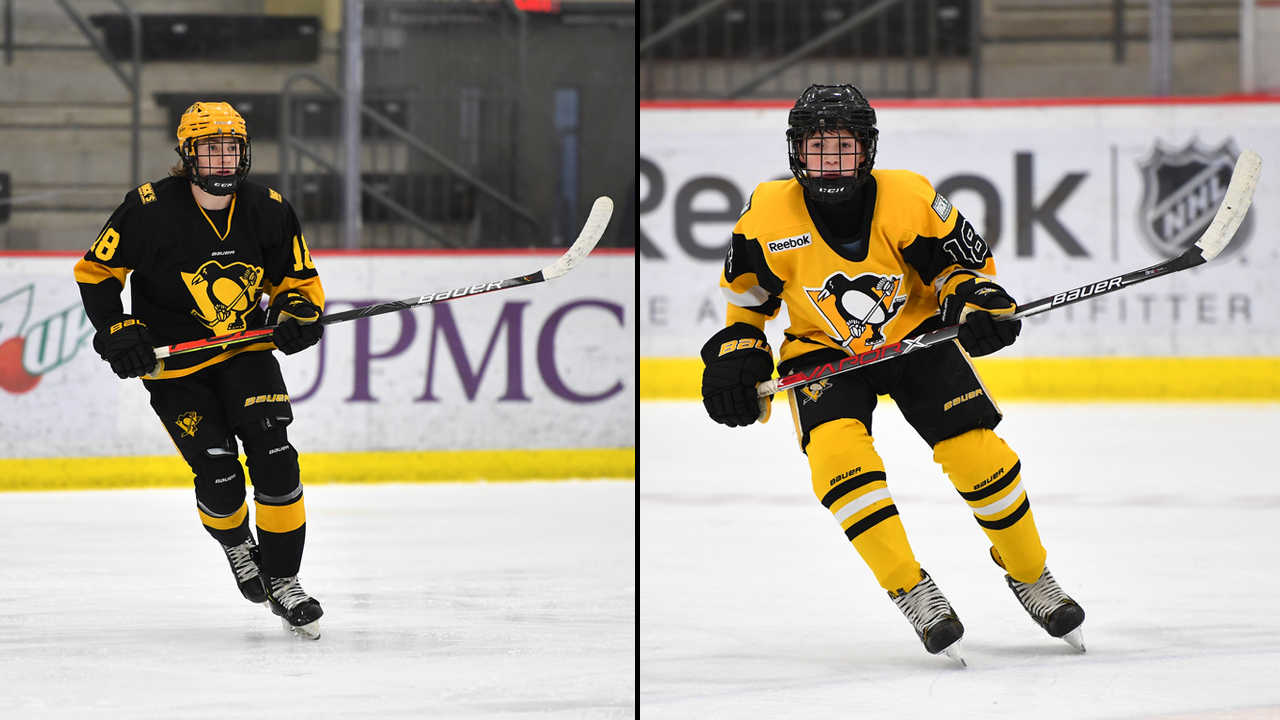
It wasn’t his only first in the Pens Elite program. The year Cooley joined, the Penguins opened a brand new, sprawling practice facility in Cranberry, Penn., and moved their triple-A team there. Suddenly, at 12 years old, Cooley was playing on the same ice Crosby and Evgeni Malkin marked up, in the same rink where the legends honed their skills, wearing a yellow Penguins jersey with ‘Cooley’ emblazoned on the back. “My first experience seeing the Pens jersey was unbelievable,” he remembers. And weird, given his Caps fandom, he admits with a chuckle.
All in all, the digs made for an overwhelming first couple months. “Just seeing how cool the facility was and everything, I wasn’t really focused on competing. I was just, you know, mind-blown by where I was playing,” he says. “But I think as time went on at the Pens Elite, I really started to grow my game, and continued to separate myself from the Pittsburgh-area kids.”
That separation didn’t take long, says Graham Harkins. The former Pens Elite bench boss coached Cooley for three years early in the young forward’s time in the program. He remembers well the very first game behind the bench with Cooley and his fellow 2004-birth-year teammates. “We were playing Team Maryland, another triple-A organization. First game of the year. We gave up a goal on the first shot,” Harkins says. He remembers shooting a look at his assistant coach, trying to convey something along the lines of, What did we get ourselves into? And then Cooley hopped over the boards. “Logan takes his first shift, goes end-to-end, and scores. And we had a tie game.
“I’m pretty sure Logan had six or seven points in the two games that weekend. I was like, ‘This is going to be a pretty fun year.’”
The strides made by his former pupil since their years together are no surprise to Harkins, who counts Cooley in a class by himself compared to the other kids he saw come through the program. “I had the pleasure of working with some pretty good players at other birth years — Division I players — but the ability Logan had to take over a game, and make his teammates better, was evident from the first game,” he says. “I mean, I sometimes would shake my head, you know? Or look at an assistant coach and go, ‘There’s nothing you can do to coach that.’ It was just God-given ability. He was just the best player on the ice.
“What I appreciate the most is his ability to make teammates better,” Harkins continues. “He could make any teammate that he played with better, but when you put him with the best possible kids, he has this ability to slow the game down, draw people to him, and create time and space for either himself or for teammates. … He can slow it down. He can play at a very fast pace. He just has a natural sense of where the space on the ice is.”
That offensive side of the game seemed to come naturally. On the other side of the puck, it was how Cooley took to the work needed to round out his game that struck Harkins most. “We sat him down in a game against Columbus because he wasn’t moving the puck and he wasn’t playing both ends,” the coach remembers. “Instead of pouting about it, he asked about it. We showed him some examples on video and he was able to implement it. And really take that not as a negative, but as, ‘[This is] something I need to work on if I want to get to where I’m going.’”
That eagerness to improve, to build, to grow, was a part of Cooley’s makeup from the very beginning. Harkins remembers seeing that drive during the centreman’s second year with the program, in his approach to earning his spot after dominating his first go-round. “It was after his peewee year. He’d probably had close to 120 points. Best player on the team. Had no worries at all about making the team for the following season,” the coach remembers with a laugh. “But after his first tryout, I knew he was not happy with how he played. And I asked him why. He said he wasn’t moving the puck and he wasn’t backchecking hard enough. In a tryout setting, where it’s very singular or individual-focused, he still had that team mentality and that wanting to be the best player on the ice. … He wanted to always be the best, to always show the best. And I thought that was something you don’t see out of 13-year-olds a lot.”
Off the ice, Cooley was no less obsessed. He was a quiet, unassuming kid, Harkins remembers, with seemingly one thing always on his mind. “Hockey was pretty much his life,” the coach says. “If he wasn’t stickhandling, if he wasn’t doing something off the ice to get better, he was on the ice playing, or he was watching one of his two older brothers play. He was kind of a rink rat.”
Moving through the program, from the Pens Elite’s U14 team to the U15s, Cooley was so far ahead of the pack, he got bumped up to play with the U16 group. “That’s kind of when I really knew that I could do something special with this game,” Cooley says. “I was taking big strides in my game, I was on the first power play for the 16s, being a younger guy, playing a ton.”
It was around that time that Cooley first heard from the U.S. National Team Development Program, the dominant American outfit that’s produced a dozen top-15 NHL Draft picks in the past half-decade alone, including five first-overall selections, most recently Auston Matthews and Jack Hughes. It was the call Cooley had been waiting for, the call he’d been working towards.
“One of our first meetings with him, I talked about player goals with him. He mentioned one of his goals was to be on the U.S. national program,” Harkins says. “I thought he had the ability to do it, but it was going to take buy-in from him, on and off the ice.
“And to his credit, he really did.”
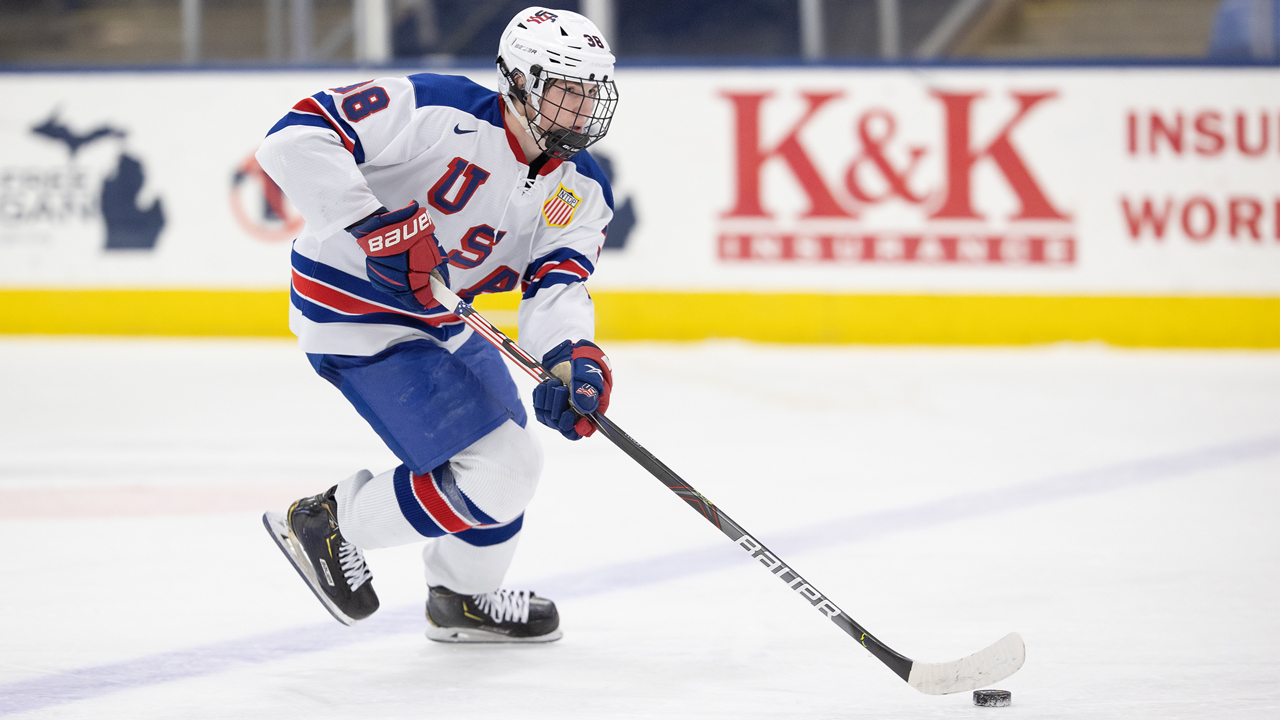
F
or a kid coming from the type of hockey community Cooley came from, the U.S. NTDP is the big-time. USA Hockey Arena, the program’s home base in Plymouth, Mich., is hallowed ground. Making that long-awaited jump, taking his talent outside of Pittsburgh for the first time in his young career after five years with the Pens Elite, brought its fair share of nerves. His mom, Cathy, made the move out to Michigan with him to ease the transition. And before long, Cooley was immersed in that high-stakes environment, making strides once again.
“Being able to compete every day in the weight room, in practice, against the best kids in the country at your birth year, it was something that you can’t have anywhere else,” he says. “Like, some practices were even harder than games, that’s just how hard we worked there. We pushed each other to be at our best every day.” Starting his stint with the NTDP’s U17 team, Cooley once again got bumped up as his skill on the sheet began to show. He split that first season, 2020-21, between the U17’s and U18’s, finishing the campaign with 20 goals and 46 points through 47 total appearances.
“I think that’s one of the reasons why they produce so many good NHL players, because there’s really no days off,” he says. “I mean, we’re all in the weight room for two hours, on the ice for two hours, and school. We’re at the rink all day long.”
Soon, he was getting his first shot on the international stage, representing his country at the 2021 U18 World Championships in Frisco, Texas. He chipped in with a pair of assists over the tournament’s five games. He soaked it all in. “I wasn’t really thinking about the NHL at the time,” Cooley says. “I was just extremely happy to be able to represent the U.S., and wear that jersey every day, and be part of that special group [against]the best kids in the world.”
The next season, Cooley came back hungry for another leap forward. Starting with the U18s, he found it, putting up 27 goals and 75 points through 51 games. The sterling showing led to more chances on the world stage, too — first in Monthey, Switzerland, where he put up seven points in four games at the 2021 U18 Five Nations tournament. Then it was on to Alberta for the World Junior Championship. Cooley put up one point in Team USA’s only game at the 2022 iteration, before COVID-19 concerns shut the tournament down early.
Getting another chance at international glory in May, at the 2022 U18 World Championships in Germany, Cooley showed out, posting 10 points in six games to earn Top Forward honours while his side took home silver. And as the points and the accolades began to stack up, Cooley’s mind began to wander once again, back to that rink on Centre Avenue. To that looming day in early July, when he’s all-but-certain to take his first steps into the big leagues.
“It’s kind of hard not to think about it, even during the season,” he says of the NHL Draft. “During the season it was something that you kind of had to let go and not really think about. But as the season ended, after Germany, I started to shift towards the Draft. Just thinking about what that day will be like. You know, seeing what kind of teams you think you’ll go to, little things like that.” He thought of celebrating with his parents, Eric and Cathy, with his uncles, his cousins. With his brothers.
“They’ve pushed me ever since I was a little kid,” he says of his siblings. “Being the younger guy going against them every day, it made me work harder every time I was on the ice with them, just because they were older and stronger. … They were always there for me. So I think to be able to share this moment with them, they’re a big part of this also. I think that’ll be a pretty cool moment for me and my brothers, and the rest of my family.”

W
hen that moment arrives, you can bet there will be a fair few cheering back home in Pittsburgh. For Cooley and for his journey, sure, but also for what it means for a city that doesn’t produce many NHLers, let alone top prospects, despite the storied history of its NHL team. “It would be something that’s really special,” says Harkins, whose own life on the ice started in Pittsburgh. “When I grew up, RJ Umberger was a first-round pick. He was about eight years older than I was. And everyone looked up to RJ as the Pittsburgh guy who made it. And then we had the [early ‘90s group]: Brandon Saad, JT Miller, Vince Trocheck, and John Gibson all kind of took the mantle as the best hockey players coming out of Pittsburgh. Since then, there’s been some Division I players, but it’s kind of cooled off a little bit.”
That chill is what the Penguins hoped to change when the team increased its investment in the city’s youth hockey community. Still, no one’s claiming they foresaw a story like Cooley’s, a local kid rising to lottery-pick status. They just wanted to give kids a way to grow in the game without leaving town. “Vincent Trocheck, John Gibson, Brandon Saad, JT Miller — all those players started their hockey careers in Pittsburgh, but once they got to a certain age they felt, for competition and exposure, they had to leave the region,” says Hixon. “Really, one of our goals was try to keep these players local. To give them the opportunity to play and stay in their hometown, up until they have an opportunity to move on and go play junior hockey.”
In Cooley, all that work has begun to come to fruition. “Logan grew up with the Pens Elite, he played for local teams, he played with local Pittsburgh kids. And that’s something that, you know, I don’t think you see as much,” Harkins says. “He did it in Pittsburgh.”
The Penguins’ efforts are also starting to bear fruit even beyond Cooley. Past the thousands of kids that took their first spins through the Little Penguins, the Pens Elite has become a dominant program on the national stage. In 2021-22, nine of its squads finished in the top-10 nationally among Tier 1 Level rankings. Since the program moved into its new facility in 2015, it’s claimed three national championships between the girls’ and boys’ sides. All that winning has spurred further interest and further growth. Pens Elite has expanded from 14 teams to 22, according to Hixon, bringing in more top-tier coaches, more pro-level resources. “The program has gone to another level across the board,” says Harkins. “Part of that is programs like the Little Penguins that’s making the access to the game more available. And then kids are playing and having fun and having some success.”
Part of it, too, is the success at the big-league level, he says, led by the originator of that Little Penguins spark. While there’s much to be said of Crosby’s legacy in the sport after a dominant career that’s seen him rack up trophies at a historic pace, much to be said of his legacy in a Team Canada sweater, and back home in Nova Scotia, for those throughout the Steel City, No. 87’s impact has been no less significant Stateside.
Armstrong moved back to Pittsburgh after his playing career came to an end in 2014. Now a hockey dad himself, he sees the impact of his former teammate’s program on a daily basis. “Everyone has a No. 87 hockey bag, all the little kids have the little No. 87 hockey jersey that you get when you sign up to do this program — I mean, in far-stretching rinks across southwestern Pennsylvania,” he says.
Another Canadian transplant who adopted Pittsburgh as home, he’s seen the weight of buying pricy gear on friends, on neighbours, on his own family. “That’s one of the biggest burdens,” he says. “I’m going to buy my kid hockey skates right now — it’s not cheap, it’s not easy. So, to be given the opportunity to try ice hockey and to be a part of that program, to be given equipment on top of it, head to toe, it just takes the headache of trying to get involved in the sport completely out of the way.”
Crosby’s efforts have begun to ease that burden beyond Pittsburgh’s city limits, too. “Around 2015, we took it to the NHL,” Morehouse told NBC. “And the NHL now has the program running in most of the NHL cities.”
Like Armstrong, Eric Neilson has had a front-row seat to Crosby’s work with youth hockey, both back in Nova Scotia and in Pittsburgh. A former teammate of No. 87’s in Rimouski, who’s remained one of his closest friends since, Neilson knows better than most how dedicated the Penguins captain is to this work. “He has so much passion for the game of hockey and so for him to give back, that gives him pure joy,” Neilson says. “It’s not something that’s forced. It’s not something that’s, ‘Oh, I have to do this.’ It’s, ‘I want to do this.’
“You know, I got to know Darryl pretty good over the years, on a personal level, away from the rink,” he continues, calling Crosby by the Darryl Sittler-inspired nickname they gave him in their QMJHL days. “It’s not too many times I’ve seen him happier than when he’s on the ice with those kids. That smile that he’s got, that’s a big, genuine smile. He’s about as happy as he’s ever going to get right there.”
And come July 7, when Cooley’s name is called, come that first game in Pittsburgh, when Cooley and Crosby’s journey will come full circle, Neilson knows his friend will be looking on with pride. “It’s just something special and it’s very, very unique. I know that Darryl will never say it, but I’m sure he’s got a little smile on the inside about that. He’s very proud of that.”
For now, Cooley’s turned his attention to the University of Minnesota, where he’s committed to suit up next season. He’s got his head down back home, skating with his cousins, his brothers, with some of those other big-league Pittsburghers who came before him. But every once in a while, when he’s driving down Centre Avenue, that thought comes back.
Centre ice, under the lights, across from No. 87.
“That’s something that for sure I’ve thought about,” he says. “It would definitely be a special moment. And I think a pretty funny moment, too. He’s the reason — he got me into hockey, you know? Made me fall in love with it, too, just watching him compete. To be able to play against him would just be crazy. It probably wouldn’t even feel real.
“To be able to play against him would just be mind-boggling.”
Chase Agnello-Dean/NHLI via Getty Images; Rena Laverty/USA Hockey’s NTDP; Joe Sargent/Pittsburgh Penguins (2); Rena Laverty/USA Hockey’s NTDP (2).


